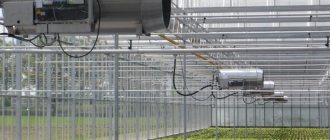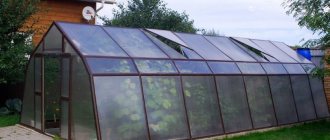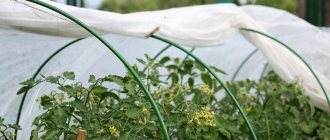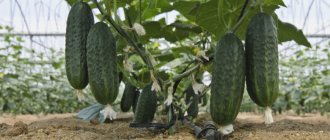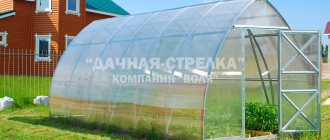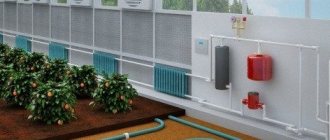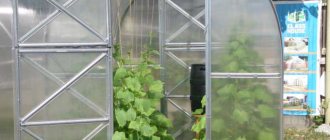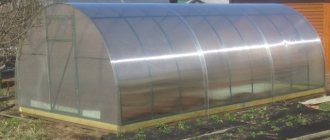Manufacturing of a bimetallic ventilation system
In order to open small vents or valve curtains, it is not necessary to construct a complex system of electric drives or hydraulic pistons. It is quite enough to install a bimetallic element so that ventilation begins when the temperature in the greenhouse increases significantly. To do this, you will need either two long and fairly narrow strips of different metals, or metal and any other material that have different expansion coefficients. Vinyl plastic with ordinary roofing iron is best suited.
Photo of a bimetallic element for automatic greenhouse ventilation
We take two long strips of these materials and rivet them along the entire length, along the perimeter, with some indentation from the edge. Then you can go in two ways. A simpler one involves attaching a strip of metal and plastic to the bottom of the board, installed vertically almost close to the window frame. Fixation is performed at two points: at the very bottom and at the level of a quarter of the length of the bimetallic element. When heated, one of the materials will begin to expand more than the other and the strip will bend, the upper end of which must be secured through a double hinge to the lower edge of the window.
We recommend that you read
- Greenhouse frame made of polypropylene pipes - profitable and fast
- Drip irrigation in a greenhouse - self-assembly
- Heating greenhouses in winter - fresh vegetables and flowers in winter
The second option is more difficult to do with your own hands, but it is at least 1.5 times more effective, and if everything is calculated correctly, then twice as effective. In order for automatic ventilation to work, you will need two bimetallic strips installed vertically and fastened in the middle with a short bar. The plate farthest from the window is rigidly fixed at the top point to the frame of the greenhouse, and the one that is connected by hinges to the frame is fixed at the lower end to a beam fixed to the floor. The free end of the far element is then attached to it on a double hinge. The stripes must be positioned in a mirror manner, that is, an element with a smaller coefficient of expansion outward.
The photo shows the operation of automatic greenhouse ventilation
How does it all work? Very simple. When heated, both bimetallic sheets begin to bend, but the far plate, which has only limited freedom from below, moves towards the window, rising on a hinge. Thus, it pushes the second strip, which also bends with its upper end towards the window. It turns out that the length of the path of the upper point of the element connected to the transom doubles. In this case, the time for tilting the sash remains the same, since heating and, consequently, bending of both bimetallic strips occurs simultaneously.
How to Make a Window in an Arched Greenhouse. Self-opening windows in a greenhouse: features
Any gardener can install a purchased automatic transom opener in a greenhouse. To do this, you only need a screwdriver and self-tapping screws. In addition, the system usually comes complete with fasteners and instructions.
However, the installation and operation of automatic vents in a greenhouse has its own characteristics:
- Self-opening windows should be located under the roof of the greenhouse: this is where hot air accumulates to the greatest extent.
- You should not place windows on the leeward side.
- For every two linear meters of greenhouse length, one transom with dimensions of 0.9x0.6 cm should be installed.
- A window with an automatic opener must be equipped with a stopper on a spring with a chain: this will prevent the mechanism from breaking when the window is opened suddenly due to gusty winds.
- The thermal drive must respond specifically to the temperature in the greenhouse, therefore, if necessary, it must be covered with a material that repels the sun's rays.
- If the greenhouse is not used in winter, at sub-zero temperatures, it is recommended to remove the cylinders of hydraulic installations to avoid ruptures of the containers.
- Light automation can be installed directly on the window frame; heavier systems (for example, an Ufopar opener with a hydraulic cylinder) must be attached to the frame of the greenhouse.
By following these recommendations, you can obtain the most effective automatic ventilation of the greenhouse, and the machine will last for decades.
Installation of fans in greenhouses
Greenhouse for grapes
To ensure constant air circulation in the greenhouse, fans are installed. Their power must correspond to the size of the structure. For example, in a greenhouse with a volume of 40 m3, a fan must move 800 m3 of air in 1 hour, that is, mix the air in the greenhouse 20 times per hour. If you install a more powerful device with a built-in speed controller, you will be able to change its power depending on the prevailing conditions.
In small greenhouses, it is advisable to place fans on one end side, and in larger structures - on both end or side walls, and at a short distance from each other. Their blades should be oriented parallel to the plane of the wall, flush with it. Instead of glass, install blinds in the wall so that they cover the ventilation holes when the fans are turned off. When they are turned on, the blinds will take a horizontal position under the influence of air flow. Supply fans should be installed in the same way. It is convenient to control the operation of such devices using a special temperature sensor to which they are connected.
The smaller the fan, the higher it needs to be installed above the floor level of the structure. In small greenhouses, it is best to install the single fan above the door. In industrial greenhouses, the dimensions of such devices exceed 1.2 m. They are placed at different heights depending on what crops are growing in the greenhouse.
The main function of fans is to circulate air in the greenhouse. At the same time, there is a uniform distribution of warm air from operating heating systems. However, in unheated greenhouses a fan is also necessary. With its help, a normal atmosphere for plant growth and development is maintained.
Place fans on the walls of the structure depending on their power. On the walls opposite them, be sure to make supply ventilation holes through which fresh air will be supplied to the operating device. Can be installed in the supply openings of blinds.
To ensure that the air entering the greenhouse contains a sufficient amount of moisture, it is recommended to moisten the material that covers the inlet openings with water. To ensure free air circulation in the room, install racks with plants at some distance from the walls.
Cold air may accumulate in certain places in the greenhouse. They can be detected using a regular thermometer. When installing it in different places of the structure, measure the minimum night temperatures. In this case, the ambient temperature must remain constant. It is more convenient to use several thermometers at once, which are hung around the entire perimeter of the greenhouse.
Dusya san: automatic device for ventilating a greenhouse
The automatic ventilation device Dusya san (sun) is a simple device and a hydraulic cylinder, and does not require electricity. This mechanism is easy to install on a door or window, and its action is based on hydraulics: when the liquid heats up, the piston moves and ventilates the greenhouse.
If the temperature drops, the liquid cools and the machine returns to its initial position, that is, the window closes:
- This unit does not develop much force, and the maximum load on it should not exceed more than 7 kg;
- If you install this device correctly and configure it, then Dusya san will last for decades;
- The opening of the window starts when the temperature reaches 20 ° C; the adjustment will have to be done manually;
- If the air in the greenhouse heats up to 30 °C, the window will open to its full length, up to 50 cm;
- If the air drops, the window will begin to close, thus maintaining the optimal temperature in the greenhouse;
- If the air in the greenhouse warms up from 50 ° C, then the device may not work correctly;
- Also, strong gusts of wind can impair the performance of the ventilator.
Dusya san - a simple device for ventilating a greenhouse
The automation of this ventilator is suitable for polycarbonate greenhouses and is combined with automatic watering. A glass greenhouse suitable for growing tomatoes is also suitable for installing the fixture.
Soil moisture and watering
DIY pipe greenhouse. Step-by-step instructions 700 photos
Another important parameter for greenhouses is soil moisture. This parameter changes at different stages of growth and maturation. The greatest need of plants for moisture is during the seedling period - up to 90-95%, as well as during the phase of fruit formation and fruiting.
Automatic watering systems
Automatic watering in a greenhouse works in different ways, but in the end everyone comes to dosing watering. Soil moisture sensors can be used but with careful modification. Chinese humidity sensors made from printed circuit boards can show accurate data for no more than a month, after which the metal surface of the contacts is destroyed and oxidized. If you use this sensor, then eventually the moment will come when you go into the greenhouse and you have a pool there, everything is flooded and your plants will probably die. Therefore, humidity sensors can be used in conjunction with a water flow sensor (water meter). You need to measure the amount of water consumed per day and set this parameter. A soil moisture sensor can be used but with modification; the contacts should be made of a material that conducts electric current and oxidizes as little as possible. It may be copper, but it also oxidizes over time, but this is already good, because You can clean the contacts once a year and use them again. But it is better to try graphite rods; graphite conducts electricity and does not oxidize. I haven’t tried it yet, but he wants to make such a sensor for testing. In general, you need to take the water meter readings as a basis, and you can turn off irrigation with a humidity sensor if it shows the maximum values. For example, in rainy weather, water consumption decreases significantly, and the set amount of water for the flow sensor may be too much. So it is better to use combined control for irrigation.
Watering is turned on using a relay based on a signal from a sensor or by time. The watering container should be at a height and it is better to water by “gravity flow” simply by opening or closing the solenoid valve. In this way, you can make a more autonomous system, because To power the controller and valves, a regular battery and a solar battery are enough. This principle of irrigation operation will be appropriate in places where electricity is often cut off for a long time.
Where can I buy
You can purchase equipment for smart greenhouses either in a specialized store or online in an online store. In the second case, the budget option for purchasing products on the Aliexpress website deserves special attention. For some products there is an option for shipment from a warehouse in the Russian Federation; they can be received as quickly as possible; to do this, when ordering, select “Delivery from the Russian Federation”:
| Automatic drive for opening Tuya window | Irrigation system with timer | Automatic watering kit for greenhouses with timer |
| Universal smart solution for remote monitoring of a greenhouse | LED grow light 1000/1500W | Smart lamp for plants with remote control |
Farm greenhouse ventilation
DIY wooden greenhouse
The flow of fresh air into the greenhouse is ensured through vents installed in the walls or roof, as well as through the doorway. In this case, the area of the area through which ventilation is carried out should be about 20% of the total. In greenhouses with a significant area, vents are provided every 2 m or in a continuous row on both sides of the roof.
The flow of fresh air into the greenhouse is ensured through vents installed in the walls or roof
Vents installed in a greenhouse can be of two types: conventional design and louvered type. Shutter windows are most often installed in greenhouses in which it is planned to grow more heat-loving vegetable crops or flowers. Their main advantage is the ability to provide fresh air without creating drafts. In addition to vents, opening doors is used to ventilate closed ground structures in calm weather.
In addition to the vents, doors are used to ventilate the greenhouse.
If your greenhouse is not attached to the house, the vent panels should face the direction of prevailing winds to allow for increased air exchange as wind speed increases. The area of the openings should be approximately 1/6 of the area of the greenhouse, and the area of the lower openings for air inlet should be 1/3 less than the area of the outlet openings, and the difference in their heights should be at least 1.8 m. This is an approximate calculation.
It is better not to open and close the windows manually. They can be equipped with a homemade hydraulic system. It consists of a container with hydraulic oil connected to the working cylinder. The principle of operation is clear: the oil expands due to high temperature, pushes the shock absorber piston, which expands and raises the transom. An option with oil that squeezes out the hydraulic cylinder rod is available for sale. It can even be adjusted at what temperature the system should operate.
There are a number of developments of direct-acting thermostats that use air as the working fluid. In the design of the thermostat by G.I. Ivanov, the transom opens due to the lifting of a flexible tank (car camera) connected to a sealed vessel fixed in the upper zone of the greenhouse (in the figure below). A flexible vessel is placed in a barrel of water; when the air expands, it increases in volume and floats up, opening the transom.
Automatic ventilation of a greenhouse according to G.I. Ivanov’s method: 1 - greenhouse design; 2 - sealed vessel; 3 - hose; 4 - camera; 5 - reservoir; 6 - water; 7 - plate; 8 - traction; 9 — window
Another thermostat is slightly different in design. In this regulator, the transom opens due to the moment created by the redistribution of the mass of water in two containers during the expansion of air. The principle of operation of the regulator is clear from the figure below.
Device for opening the transom: 1 - transom; 2 — adjusting strips; 3 - a vessel with water with a capacity of 2-4 liters; 4 — hole d=5 mm; 5 - flexible hose; 6 - vessel with a capacity of 10-20 l
Sometimes the ventilation system of greenhouses is supplemented by installing exhaust and circulation fans. An exhaust fan is used to remove warm air from the greenhouse. It is installed on a segment of glass roof covering, replaced by a sheet of tin or an asbestos-cement slab.
Circulation fan
A circulation fan is installed inside the greenhouse. It moves the air in the greenhouse, helping to distribute heat and moisture evenly, which improves plant growth conditions. A good household fan is quite suitable for these purposes. Some models of electric heaters for greenhouses can operate in circulation fan mode: pumping air without heating it.
Video: Ventilation
in
a greenhouse
with your own hands it is possible
Find out more about ventilation in a greenhouse:
— How to make a window; — Thermal drive for greenhouse; — How to ventilate a greenhouse; — How to make a hydraulic cylinder for a greenhouse.
All our articles from the category: Greenhouses and greenhouses →→→
Source 1 Source 2
Ventilate the greenhouse properly
Every gardener or gardener dreams of an ideal greenhouse that ventilates itself. And this dream is quite feasible in our time, given the availability of a huge number of modern automatic window openers.
Ventilation is very important when growing greenhouse plants.:
- Incorrect temperature can destroy plants (above 40 oC plants dry out);
- If the temperature is constantly above 32 ° C, then the crops stop producing fruit;
- Regular ventilation allows you to avoid many diseases, for example, mold and other fungi that can kill seedlings;
- Incorrect temperatures can slow down plant growth.
To make the plants comfortable in the greenhouse, it is necessary to properly ventilate it.
It is the correct temperature that is the basis for a good harvest and healthy crops. To facilitate this process, special automatic ventilation mechanisms have been invented. We ventilate the greenhouse correctly using a ventilator.
Ventilation system design
The design of the mechanism for opening and closing the greenhouse vents, driven by a gear motor, ensures their simultaneous raising or lowering over the entire area of each greenhouse compartment. Opening can be done automatically and remotely. The lifting angle of the vents and the area of the ventilation opening are adjusted depending on the air temperature, wind speed and precipitation.
Each mechanism consists of rack and pinion gearboxes installed on the upper belt of trusses in the central part of the greenhouse with slats, rods, and roller supports.
For optimal air distribution and improvement of the microclimate conducive to plant growth, industrial greenhouses are equipped with forced ventilation. For this purpose, special exhaust fans are used, with a multi-stage rotation speed controller. During operation, fans mix (create circulation) hot and cold air, contributing to a more uniform distribution of temperature fields, reducing overheating of plants, accelerating the physiological processes of plant growth, and eliminating areas with high humidity. The most forced air circulation is effective in climatic periods when natural circulation through transoms and vents is ineffective or impossible at all.
Automatic ventilation differs in operating principle and is divided into types:
- Electric - the most common type of ventilation, usually includes a fan and a thermostat. The device turns on when the temperature in the greenhouse becomes higher than the set one.
- Hydraulic is a reliable and durable type of ventilation. Lasts a long time. The design of the system is based on levers connected by a transom. The role of a thermal relay is played by a reservoir with liquid. When a liquid heats up, it expands; when it cools, it decreases in volume. The vessel inside the greenhouse is a thermometer, the container outside is a compensator. They are connected by hydraulic hoses.
- Bimetallic - rarely used. Based on the difference in expansion coefficients of two metals. When heated, one plate bends and opens the window. The window closes when the plate cools down.
Profit Agro carries out work on the design and installation of ventilation systems for industrial greenhouses, and can also carry out a comprehensive supply of equipment for ventilation systems in greenhouses. Our company offers to buy greenhouse fans at a wholesale price.
UFOPAR: device for ventilation of greenhouses
UFOPAR is a universal ventilator for greenhouses, has good self-ventilation. The window opens and closes when temperatures from 16 to 25 ° C are reached in the greenhouse. The design is perfect for greenhouses with tomatoes, where it is especially necessary to monitor the optimal temperature in the greenhouse. The controller is hydraulic, the oil heats up and causes the rod to be forced out, thus opening the window. The window closes if the temperature of the oil decreases and causes it to shrink. Installing this auto-ventilator does not take much time and effort; you just install the machine on the frame and window in the greenhouse.
UFOPAR is a universal ventilator for greenhouses that can last for many years
You need to use the ventilator correctly, then it will last a long time:
- If necessary, lubricate the moving parts of the mechanism;
- A sun screen must be installed on the so-called opener umbrella so that the machine does not get knocked down and does not heat up from the sun;
- With the onset of frost, it is better to remove the device to extend its service life;
- To prevent the rod from biting, you need to apply a small axial force.
UFOPAR is not equipped with an electric drive, which makes it an absolutely safe and convenient automatic window opener in the greenhouse.
Mounting options
Windows located under the roof can be mounted either on rotary hinges, as in the photo below, or the hinges will be located on the upper side of the transom. The choice of transom design will not have a significant difference on the microclimate in the greenhouse, but if you plan to install an automatic window opening system in the future, then calculate in advance exactly how you will attach it.
In an emergency option (let’s say you didn’t calculate the temperature conditions in advance), they don’t make a frame for the transom; they simply cut polycarbonate along three of the four sides of the hatch, bend the top edge so that it moves freely up and down, and screw a stiffener to the bottom (a section of a profile or even the rail). This emergency construction will come in handy for the few days while we prepare the necessary materials and install the windows correctly.
This video will help you make windows in a greenhouse with your own hands and avoid minor annoying mistakes. Please watch the tutorial before getting started.
Market overview of industrial manufacturers of smart greenhouses
The market for smart greenhouses is becoming increasingly resilient. This is facilitated by the development of the following technologies:
- application of additional lighting technology based on light-emitting diodes (LED technology);
- in addition to wired, wireless communication is used for connection;
- improvement of irrigation system designs;
- improvement of technical characteristics of pumps and valves;
- an increase in the number of factors that indicate the occurrence of an emergency situation during its monitoring;
- application of advanced achievements in the field of IT technologies.
Rated manufacturers of smart greenhouses offer their products depending on the size of the greenhouse complex; technical solutions are selected in accordance with the type of crops grown.
On an industrial scale, smart greenhouses are used in northern latitudes. Vegetables and fruits that are exotic for the northern regions and grown in smart greenhouses will be much cheaper than those imported from the southern regions.
The intelligent segment of agriculture in the form of smart greenhouses will develop at a rapid pace thanks to domestic manufacturers. The government's focus on the digital economy will contribute to this.
The Netherlands and some other European countries are at the forefront of developing controlled environment agriculture technologies. The implementation of smart greenhouses is developing at an accelerated pace in India, Japan, and China.
Dominant positions in the smart greenhouse market are occupied by Rough Brothers (USA), Heliospectra (Sweden), GreenTech Agro (Netherlands) and others.
Non-volatile devices
Automatic ventilation for greenhouses made of glass or polycarbonate can be realized without the help of electricity and complex electronic devices, using the inherent ability of any substance to shrink or expand when temperature changes.
Video:
The mechanisms for ventilating greenhouses based on this principle are quite simple, and therefore can easily be done with your own hands.
Based on the type of working environment used, they are divided into three types.
Solid-state mechanisms for ventilation
This type includes bimetallic plates widely used in various thermostatic installations.
For example, steel can be combined with copper, brass, aluminum or even plastic.
The ends of the parts must be firmly fixed.
Since when the temperature changes, the metals receive different elongations, the bimetallic plate will begin to bend, which means that the greater the temperature difference, the greater the degree of its curvature.
If one end of such a plate is firmly fixed, and a plastic tube stop connected to the transom is attached to the other, the element will begin to act as a drive for the auto-ventilation system.
Of course, the sash should not be too heavy, so it is better to make it from polycarbonate.
Pneumatic mechanisms for ventilation
The pneumatic mechanism for automatic ventilation consists of only two components:
- receiver;
- pneumatic cylinder.
Don't let the complicated names scare you - all the components can be easily made with your own hands.
The receiver is simply a metal canister, hermetically sealed with a stopper with a hole for a flexible hose.
In order for the foam piston to slide easily inside the cylinder, it is covered with tape, and the inside walls of the body are lubricated with Vaseline.
An inflatable rubber ball is placed under the piston in the cylinder, passing the “tail” intended for inflating it through the hole in the bottom to the outside.
All that remains is to connect this ball to the receiver using a rubber hose.
The system works as follows.
As a result, the sash opens slightly and cool outside air begins to flow into the greenhouse.
In this option, the weight limitation also applies: it is better to make the transom from polycarbonate.
Liquid mechanisms for ventilation
The design described below is the easiest to make with your own hands.
Strictly speaking, the working medium here is also air; water rather plays the role of a drive.
The greenhouse window leaf can be made from either glass or polycarbonate, but two technical conditions must be met:
- the transom must rotate relative to a centrally located horizontal axis, and in such a direction that to open the window, the inner part of the sash must be pulled down;
- To limit the angle of rotation of the transom, you should secure a stop made of a wooden block.
This ventilation system also has a tightly closed receiver, only you need to pour about 1 liter of water into it, and insert a brass tube into the plug, almost reaching the bottom.
The receiver is connected with a flexible hose to the can, which is similarly equipped with a tube passing through the lid and hung on the window leaf from the inside.
Outside, we attach a counterweight to the window, which under normal conditions should balance the jar (balance is achieved by adding a certain amount of water to the jar).
When heated, the air in the receiver will displace a portion of the liquid into the jar, causing its weight to increase.
The window will open slightly.
When the temperature drops, the receiver (it is better to install it at the highest point of the greenhouse) will draw the water back, the jar will become lighter and the window will close.
Controller
The controller processes information and gives commands for the actions of actuators. This is a programmable electronic device that, according to a given algorithm, ensures the implementation of all agrotechnical tasks for caring for plants.
In addition to the electronic circuit itself and a set of sensors, the delivery package includes control and visualization programs.
As an example, we give the functionality of one type of Russian-made controller:
- control according to a program designed to operate throughout the day, where the initial data are the values of temperature and humidity;
- the position of the thermal drive for opening the vents is regulated by an algorithm for finding its most effective position for solving the task;
- finds optimal cooling options during critically high summer temperatures;
- performs micro-ventilation mode while maintaining optimal humidity;
- organizes automatic watering in the greenhouse with the addition of water to the tank and control of the supply to the plants together with the supply of the nutrient solution;
- participates in the preparation of the nutrient solution, controlling its composition;
- controls the heating system based on sensor readings;
- performs calculations of solar energy received by plants in a certain period of time;
- controls humidity simultaneously in several zones;
- operates with temperature data at several specified points in the greenhouse.
This set of functions qualitatively improves the conditions for growing plants in a greenhouse.
Greenhouse ventilation automatically, varieties and implementation
Automatic ventilation system is divided into the following types:
- electric - the cost is low, and the thermostat contains an electric fan; operation occurs when the temperature inside the greenhouse rises above the set value;
- hydraulic type - durable, not reliable installations. The design consists of levers that are connected by a transom; the thermal relay is a tank containing liquid inside. When heated, the liquid expands, cools, and the volume becomes smaller. The thermometer is presented in the form of a vessel, and there is a compensator outside, all this is connected by hydraulic hoses;
- bimetallic ventilation - the expansion of metals has a different coefficient, when the metal heats up, the bending of the plate pushes the window to open, and when it cools down it closes automatically;
- automatic type of window operation.
A fan connected to a thermostat is the simplest type of equipment for a greenhouse, while the exhaust system can be called natural. This is a very simple mechanism, based on the fact that as the temperature rises, the relay activates and the fan starts. Heated air is sucked out of the greenhouse and replaced with fresh air.
If the window opens automatically, and a fan turns on on the opposite side, then the ventilation system can be called a supply ventilation system. The fan blows in cool air, which reduces the humidity and temperature inside. With this design, it is possible to set precise parameters on the equipment; with any change in the design, the fan can be reconfigured. We must not forget that installation requires electricity, and installation of automatic opening is not an easy task.
The operating principle of a smart greenhouse
The diagram below of how a smart greenhouse works shows the extent of human participation in its functionality. User input is limited to software adjustments and direct setting of controller parameters. The adjustment can be carried out remotely through, for example, a computer connected to the controller.
The automatic operating mode is provided by sensors and a controller with electronic control circuits, which ensure the operation of the actuators in the required mode.
Methods of provision
The simplest thing you can do with your own hands is to personally control the climate in a polycarbonate room and manually influence the flow of air flow. To measure basic parameters, you will need a couple of simple instruments: a thermometer to determine temperature and a hygrometer to determine humidity. As for regulating ventilation, there are standard means for this:
- doors;
- window;
- transoms/windows.
Using these devices, you can quite successfully adjust the degree of ventilation, depending on the weather and the position of the Sun above the horizon. However, this is cheap in terms of minimal equipment costs, but equally wasteful in terms of time spent. To ensure a rich harvest in a polycarbonate structure, you will need to live somewhere nearby, and not everyone can afford this.
Fortunately, constant automation of routine processes is not unique to industry. Currently, the following methods are identified to facilitate the work of owners of polycarbonate and other artificial housing for vegetables and fruits:
- electrified greenhouse ventilation system;
- hydraulic automation;
- automatic devices based on bimetals;
- so-called "smart" windows.
Manual window for greenhouse
Almost any method can be easily organized with your own hands. The type of ventilation can be either natural, in which the process is carried out due to the difference in temperature inside the polycarbonate structure and outside, or forced. In the latter case, special outdoor (street) fans are used, working together with or without a thermoregulation device. This option is advisable to install in large greenhouses.
Classification of smart greenhouses
Any system in which any action is performed must have external energy sources for this. According to the method of using such energy, smart greenhouses can be classified into the following groups:
- autonomous - uses natural sources of thermal energy, for example solar;
- dependent on industrial energy sources - power is supplied from the electrical network.
The disadvantage of an autonomous system is the inertia of the automatic system, which, due to untimely operation of the actuators, does not guarantee the normal functioning of plants.
Energy-dependent operating systems of a smart greenhouse may have an emergency shutdown, which will have the worst consequences for the plants.
Based on the design and purpose of greenhouse complex devices, the following categories can be distinguished.
- Greenhouse. This is a room for growing exotic plants for which the climate of the area is not suitable. Usually covered with glass and used for scientific purposes to study the development of unusual plants.
- Greenhouse. These are premises for year-round cultivation of vegetables, berries and seedlings. Covered with a lightweight transparent material such as polycarbonate. The main goal of greenhouses is to obtain a high yield of vegetables and berries in a short agrotechnical time frame, regardless of the surrounding weather conditions.
- Greenhouse. The main purpose of a greenhouse is to grow seedlings. Usually this is a small portable structure covered with an easily rolled transparent film. The heat in it is created by natural energy sources.
Correct breathing
In a well-designed greenhouse there are at least two vents, and they are located at the extreme vertical points: one at the bottom, and the second under the ceiling, so that natural air circulation occurs. To ventilate a small room, this is usually sufficient.
Installation of ventilation vents
But sometimes an abundance of tall plants, or a greenhouse tunnel that is too long, does not allow air to circulate properly. This is very easy to determine by the abundance of condensation, which settles from the inside on the polycarbonate and then rolls down onto the plants, which is very undesirable. In such cases, the owner of the greenhouse has to modify the structure of the structure with his own hands. As a rule, additional windows are installed on the ceiling.
Opening system
Sensors as the basis of information for a smart greenhouse
The following types of sensors, integrated in a digital format to transmit a signal to the controller, transmit time-varying parameters to the smart greenhouse control unit:
- air temperature sensors
- air humidity sensors
- soil temperature sensor
- soil moisture sensor
- light sensor
In addition to the sensors presented above, there are many others that some agricultural producers use in their activities: dew point sensors, soil chemical composition sensors, irrigation water quality control sensors and others.
We recommend reading: how to make a soil moisture sensor for an irrigation system with your own hands.
Types of ventilation systems for greenhouses
All types of ventilation in enclosed spaces can be divided into two types, forced and natural. Natural ventilation includes the installation of vents, when opened, the exhaust air is replaced with fresh air. You can build such a greenhouse ventilation system yourself without spending additional money on installation and equipment. The disadvantage of such ventilation is the low efficiency and difficulty of controlling the inflow and outflow of air. The forced system does not have these disadvantages and is the optimal method for creating a healthy microclimate in the greenhouse. Forced types of ventilation include:
- Hydraulic systems.
- Bimetallic systems.
- Professional systems.
- Electrical systems.
Let's consider each type of system separately to understand what disadvantages and advantages this or that ventilation has.
Hydraulic system
This type of ventilation is considered one of the most reliable and effective, and the system can easily be created with your own hands. The essence of hydraulics is the ability of the liquid to expand, which ensures the opening of the windows. To set up such a system in polycarbonate greenhouses with your own hands, you will need a container of water and levers connected by a transom. When heated, the water expands and the transoms open; as the temperature decreases, the process occurs in the opposite direction. The only drawback of hydraulics is the slow closing of the transoms when the temperature drops. If the outside air becomes very cold, heat-loving crops may suffer. Therefore, owners of such systems are advised to monitor the weather and, if necessary, take measures to protect plants.
Bimetallic system
Some do-it-yourselfers who understand the properties of metals can arrange the ventilation of a greenhouse with their own hands and build a fairly effective and reliable bimetallic ventilation system. The essence of the action of such an installation lies in the ability of metals to expand and contract. By installing a plate of two metal sheets with different characteristics on the window, you can achieve almost automatic ventilation. When heated, the plate will expand and bend, which will facilitate the opening of the window. When it cools, on the contrary, the metal will shrink and the window will close. This design does not require the constant presence and control of the greenhouse owner. However, this ventilation also has a number of disadvantages, the main one of which can be considered to be effective only for small vents.
Electrical system
A ventilation system using simple electrical appliances can be the most effective option for maintaining the required microclimate. To create such an installation with your own hands, you need to purchase several fans and a temperature sensor. By connecting the fans to the temperature controller, and then to the network, you will get a system that will turn on the ventilation of the greenhouse automatically when the set temperature rises. The only disadvantage of the system is its dependence on the power grid. However, the problem of power outages can be easily solved by installing solar panels on the roof of the greenhouse. In this case, you will not only ensure uninterrupted power supply, but also save on utility bills.
Professional system
Today, in specialized stores you can purchase ready-made, professional ventilation systems for greenhouses. These designs are highly efficient, durable and reliable. Installation of such a system is not difficult and can be done independently by reading the instructions. Professional ventilation of a polycarbonate greenhouse protects crops from freezing, the development of diseases at high humidity, and the death of plants from stagnant air. Among the disadvantages of professional systems, one can highlight the high cost of equipment compared to home-made installations. However, over time, automation pays off, because with high-quality ventilation, productivity increases significantly and fruit losses are reduced.
Correct placement of vents in the greenhouse. General rules for the device
Windows in a greenhouse are a necessary condition for creating the correct indoor microclimate; they help regulate the temperature and humidity of the air, which is the key to a good harvest. Proper ventilation will help avoid infection of the greenhouse and will greatly reduce the possibility of harmful insects and microorganisms appearing.
Look at the instructions explaining how to install a window in a polycarbonate greenhouse, at
How much to do
When organizing the ventilation of a greenhouse, the question arises: how many vents should there be? Here we turn to the advice of experts who recommend installing 1 transom measuring 900*600 mm for every 2 m/p, so if the building is 3 m, then it is better to make 2 pieces, as well as for a 4-meter building. It is generally accepted that the total area of opening openings should be at least 20-25% of the total area of the greenhouse, which is sufficient for proper ventilation of the room.
Good to know: If the greenhouse structure has partitions dividing it into 2 or more parts, then it is important to install vents in each section in order to organize proper air circulation.
Location
Due to the nature of warm air rising upward, the vents should be located at the top of the structure: mounted in the roof or openings made, retreating 2/3 in height from the base of the structure.
The placement also depends on the location of the building. So, if the greenhouse is installed on the sunny side and along the ridge is directed from east to west, as recommended by agronorms, then 2-3 opening transoms are sufficient for a structure 6 m long. But in regions with high humidity, as well as in damp areas, more should be provided number of vents.
Advice: Even if you bought a ready-made greenhouse, where all the opening elements were calculated by specialists and provided for by the design, when placing the building in an area with high humidity, you should install additional vents.
The upper position of the opening transoms reduces the likelihood of drafts
According to reviews from experienced gardeners, it is not recommended to place opening elements near the front door, this will help avoid:
- drafts;
- slamming transoms during gusts of wind:
And it will allow air flows to be evenly distributed. If you designed and built a greenhouse with your own hands, then first the opening should be made in the middle of the length of the building, and the remaining windows should be placed at an equal distance from it.
Reviews of ready-made smart greenhouse projects + prices and photos
Examples of the most common models of finished projects are presented in the table below:
| Model name | Peculiarities | Price, rub. | Photo. |
| Domestic | |||
| Smart greenhouse (4*2*2 m) | They are standard or made to order. Made from polycarbonate. Equipped with thermoregulation and automatic watering systems. Service life – 15 years. | from 7200 |
|
| Novator-4 (in “Comfort”, “Classic”, “Premium”, “Elite” trim levels); sizes vary | An arched model with a pipe cross-section of 4*4 cm and a distance between the arches of 0.66 m. Made of polycarbonate. Withstands up to 160 kg of snow per m2. | from 11000 |
|
| LIFE ENERGY-4 (standard and optional) | Year-round. Made with single-chamber double-glazed windows. Equipped with automatic systems: watering, ventilation, lighting and heating. | 524600-1573900 |
|
| LIFE ENERGY-5 | Year-round, 4 m wide. Made with ventilation hatches (2-6) with automatic drive. Equipped with automatic systems: watering, ventilation, lighting and heating. | 626100-1848300 |
|
| YoTik (educational electronic construction set) | The set includes: a case in the form of a designer, a YoTik v1.0 controller, an Arduino expansion board, a 20 cm LED strip, modules for four relays and a power MOS transistor, an electric pump, a water supply tube; as well as sensors for light, temperature, air humidity, and soil. | 15 000 |
|
| Arduino Mega | The design allows you to create a greenhouse with functions of automatic control of temperature, humidity, lighting, irrigation, and creation of the necessary microclimate. Control is possible remotely. | 15 000 | |
| “Smart greenhouse” according to Kurdyumov | Automated modes are provided: air temperature control, soil mulching, drip irrigation, and ventilation. | 22700-77000 |
|
| Foreign production | |||
| WERDEBOX (created in Italy) | Lighting sources are LEDs. Crops can be grown on 4 tiers. Special capsules are provided for plant growth. Thanks to its modern design, the greenhouse easily fits into almost any interior. | 600 000 |
|
